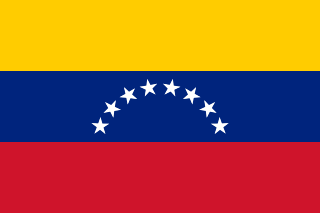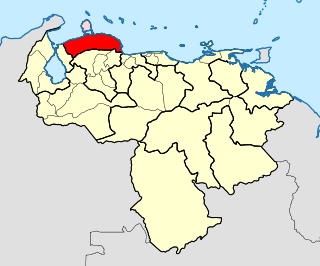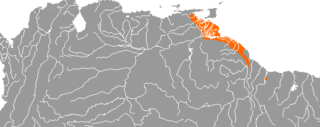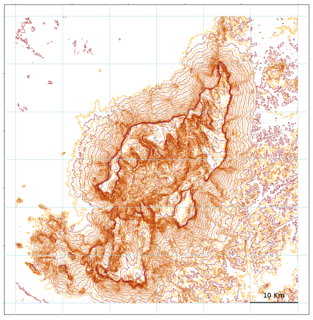
Venezuela, officially the Bolivarian Republic of Venezuela, is a country on the northern coast of South America, consisting of a continental landmass and many islands and islets in the Caribbean Sea. It has a territorial extension of 916,445 km2, and the population of Venezuela was estimated at 28 million in 2019. The capital and largest urban agglomeration is the city of Caracas.

Simón José Antonio de la Santísima Trinidad Bolívar y Ponte Palacios y Blanco, generally known as Simón Bolívar and also colloquially as El Libertador, "the Liberator", was a Venezuelan military and political leader who led what are currently the countries of Venezuela, Bolivia, Colombia, Ecuador, Peru, and Panama to independence from the Spanish Empire.

The Orinoco is one of the longest rivers in South America at 2,250 kilometres (1,400 mi). Its drainage basin, sometimes known as the Orinoquia, covers 880,000 km2 (340,000 sq mi), with 76.3 percent of it in Venezuela and the remainder in Colombia. It is the fourth largest river in the world by discharge volume of water. The Orinoco River and its tributaries are the major transportation system for eastern and interior Venezuela and the Llanos of Colombia. The environment and wildlife in the Orinoco's basin are extremely diverse.
The Colonia Tovar dialect, or Alemán Coloniero, is a dialect that is spoken in Colonia Tovar, Venezuela, and belongs to the Low Alemannic branch of German.

Auyán Tepui, also spelled Ayan, is a tepui in Bolívar state, Venezuela. It is the most visited and one of the largest tepuis in the Guiana Highlands, with a summit area of 666.9 km2 (257.5 sq mi) and an estimated slope area of 715 km2 (276 sq mi). The unevenly heart-shaped summit plateau of Auyán-tepui is heavily inclined, rising from around 1,600 metres (5,200 ft) in the northwest to a maximum of 2,450 m (8,040 ft) in the southeast. It is incised from the north by a vast valley, the Cañón del Diablo, formed by the Churún River. The larger western portion of the plateau is partially forested, whereas the eastern part comprises mostly bare rock with only patchy vegetation cover. The mountain hosts a number of extensive cave systems.

Oncidium, abbreviated as Onc. in the horticultural trade, is a genus that contains about 330 species of orchids from the subtribe Oncidiinae of the orchid family (Orchidaceae). As presently conceived, it is distributed across much of South America, Central America, Mexico and the West Indies, with one species (O. ensatum) extending into Florida. Common names for plants in this genus include dancing-lady orchid and golden shower orchid.

.ve is the Internet country code top-level domain (ccTLD) for Venezuela.

Rafael Édgar Dudamel Ochoa, commonly known as Rafael Dudamel, is a Venezuelan football manager, currently in charge of Chilean club Universidad de Chile and former player who played as a goalkeeper.
The Regions of Venezuela are two groupings of Venezuela's states, capital district, and federal dependencies. Venezuela's natural regions are divided by natural geography, and administrative regions are delineated for the purpose of regional administration.
The languages of Venezuela refers to the official languages and various dialects spoken in established communities within the country. In Venezuela, Castillan is the official language and is the mother tongue of the majority of Venezuelans. Although there is an established official language, there are countless languages of indigenous villages spoken throughout Venezuela, and various regions also have languages of their own.

The Roman Catholic Archdiocese of Coro is a Latin Metropolitan archdiocese in western Venezuela.

Mourasuchus is an extinct genus of giant, aberrant caiman from the Miocene of South America. Its skull has been described as duck like, being broad, flat and very elongate, closely resembling what is seen in Stomatosuchus, an unrelated crocodylian that may also have had a large gular sac similar to those of pelicans or baleen whales. Mourasuchus, is a strange nettosuchid with an unusually long, broad snout.

Venezuelan people are people identified with Venezuela. Venezuelans are predominantly Roman Catholic and speak Spanish. The majority of Venezuelans are the result of a mixture of Europeans, Africans and Amerindians. Approximately 51.6% of the population are Pardos of mixed European, African, and Amerindian ancestry; 43.6% of Venezuelans identify as European, 3.6% identify as being Afro-Venezuelan and 2.7% identify as being Amerindian.

Warao is the native language of the Warao people. A language isolate, it is spoken by about 33,000 people primarily in northern Venezuela, Guyana and Suriname. It is notable for its unusual object–subject–verb word order. The 2015 Venezuelan film Gone with the River was spoken in Warao.
Ikanogavialis is an extinct genus of gryposuchine gavialoid crocodilian. Fossils have been found in the Urumaco Formation in Urumaco, Venezuela and the Solimões Formation of Brazil. The strata from which remains are found are late Miocene in age, rather than Pliocene as was once thought. A possible member of this genus survived into the Late Holocene on Muyua or Woodlark Island in Papua New Guinea.
Nephelomys caracolus, also known as the Costa Central oryzomys or caracol rice rat, is a species of rodent in the genus Nephelomys of family Cricetidae. It is found in cloud forest in the Cordillera de la Costa Central of Aragua, Miranda, and the Distrito Federal in north-central Venezuela at elevations from 1000 to 2500 m. It is nocturnal and terrestrial, and has a varied diet. In most Nephelomys species, the posterolateral palatal pits, perforations of the palate near the third molar, are conspicuous and receded into a fossa, but in N. caracolus and the Ecuadorian species N. nimbosus, the pits are much smaller.

Agencia Venezolana de Noticias (AVN) is the national news agency of Venezuela. It is part of the Ministry of Popular Power for Communication and Information (MINCI), but is run as an autonomous service. It reports on national and regional issues, as well as on Latin America in general.

Cerro de la Neblina, also known as Serra da Neblina in Brazil and Sierra de la Neblina in Venezuela, is a sandstone massif located in the northern Amazon Basin. It is a tilted, heavily eroded plateau, with a deep canyon in its central portion, drained by the Baria River.
Ye'kuana, also known as Maquiritari, Dekwana, Ye'kwana, Ye'cuana, Yekuana, Cunuana, Kunuhana, De'cuana, De’kwana Carib, Pawana, Maquiritai, Maquiritare, Maiongong, or Soto is the language of the Ye'kuana people of Venezuela and Brazil. It is a Cariban language. It is spoken by approximately 5,900 people around the border of northwestern Brazilian state of Roraima and Venezuela – the majority in Venezuela. At the time of the 2001 Venezuelan census, there were at 6,523 Ye’kuana living in Venezuela. Given the unequal distribution of the Ye’kuana across two South American countries, Ethnologue lists two different vitality ratings for Ye’kuana: in Venezuela it is listed as Vigorous (6a), while in Brazil it is classified Moribund (8a) on the Graded Intergenerational Disruption Scale (GIDS).












